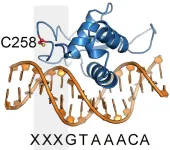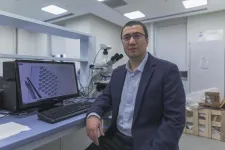(Press-News.org) LA JOLLA, CA—Hormone-driven cancers, like those of the breast and prostate, often rely on a tricky-to-target protein called Forkhead box protein 1 (FOXA1). FOXA1 mutations can enable these types of cancers to grow and proliferate. Today, FOXA1 is notoriously difficult to block with drugs—but that may soon change.
Scripps Research scientists have identified a crucial binding site on FOXA1 that could pave the way for future cancer treatments. The team’s findings, which were published in Molecular Cell on October 15, 2024, also mapped out how tiny drug-like chemical compounds—called small molecules—interact with the protein.
While examining protein interactions on a large scale, investigators in the lab of co-corresponding author Benjamin Cravatt, PhD, the Norton B. Gilula Chair in Biology and Chemistry, determined that small molecules could, in fact, interact with FOXA1.
“FOXA1 had historically been considered undruggable,” says Cravatt. “It’s thought to lack the types of surfaces that small molecule drugs can bind to, which is likely why it’s been so difficult to target the protein.”
Following its discovery, Cravatt’s lab teamed up with the lab of Michael Erb, PhD, to better understand how those molecules might affect the functions of FOXA1.
Both Cravatt and Erb used two forms of activity-based protein profiling (ABPP), a technique that Cravatt’s lab pioneered to capture protein activity on a global scale. The dual approach allowed them not only to determine whether a small molecule could bind to FOAX1 at all, but also to pinpoint the exact binding site.
Erb and his group are particularly interested in how certain genes are turned “on” and “off” by proteins called transcription factors, and how this leads to cell states that cause cancer. Transcription factors like FOXA1 bind to specific regions of DNA and control whether a gene is activated (turned “on”) or repressed (turned “off”). This regulation is essential to how cells function and respond to changes—such as in the case of hormone-driven cancers, which often depend on FOXA1 to grow.
“FOXA1 is a master regulator of gene control, or what we call a lineage-defining factor,” says Erb, the study’s co-corresponding author and an associate professor in the Department of Chemistry. “We found a specific site on FOXA1 that can bind to small molecules, which is a tremendously important discovery since transcription factors like FOXA1 are not only attractive targets for cancer, but also many other diseases.”
Because it’s so rare to find a small molecule binding site on a transcription factor, the discovery was unexpected.
“A common analogy is that drugs bind to proteins like keys inside a lock, but the prevailing attitude is that most transcription factors don’t have binding sites to unlock,” adds Erb. “The binding site on FOXA1 is like a hidden lock; without the ABPP technology as it exists today, it’s hard to imagine how we would have discovered it.”
Another surprising finding: FOXA1 usually binds to a distinct sequence of DNA bases to control gene regulation—but binding FOXA1 to small molecules changed the sequences that it preferred, allowing the protein to target different genes than it normally would.
This discovery may help future researchers understand how such molecules affect gene regulation in cancer. If small molecules alter FOXA1’s DNA preferences, they could influence which genes are turned on or off—potentially affecting cancer growth.
“We found small molecules could impact FOXA1’s ability to interpret the information written into the genome,” says Erb.
Furthermore, the team determined that certain mutations in FOXA1 affected areas close to where small molecules could attach to the protein. These mutations changed how FOXA1 interacted with DNA—in the exact same way that the small molecules did.
“This suggests that a hotspot for cancer-associated mutations is also a hotspot for small molecule binding events,” points out Erb.
Contrary to what they originally thought, the researchers found that small molecules couldn’t just attach to FOXA1 on their own. Instead, they could only bind to FOXA1 when the protein was already bound to DNA sequences—meaning the effectiveness of small molecules as cancer treatments probably relies on FOXA1’s interactions with DNA.
Looking ahead, Erb and Cravatt plan to explore the optimization of FOXA1 ligands into antagonists of its function and cancer growth, as well as to use ABPP to search for small molecule binding sites on transcription factors beyond FOXA1 that are currently considered undruggable.
“Now that we’ve created chemical probes to study FOXA1, we hope our research inspires the development of drugs that can target the protein,” says Cravatt.
In addition to Cravatt and Erb, authors of the study, “Redirecting the pioneering function of FOXA1 with covalent small molecules,” include Sang Joon Won, Yuxiang Zhang, Christopher J. Reinhardt, Lauren M. Hargis, Nicole S. MacRae, Kristen E. DeMeester, Evert Njomen, Jarrett R. Remsberg and Bruno Melillo of Scripps Research.
This work was supported by funding from the Howard Hughes Medical Institute Hanna H. Gray Fellowship (GT15176); the Jane Coffin Childs Memorial Fellowship; the National Institutes of Health (F32 CA265211, R35 CA231991, DP5-OD26380 and 1R01CA280720-01A1); and the Ono Pharma Breakthrough Science Initiative Awards Program.
//
About Scripps Research
Scripps Research is an independent, nonprofit biomedical institute ranked one of the most influential in the world for its impact on innovation by Nature Index. We are advancing human health through profound discoveries that address pressing medical concerns around the globe. Our drug discovery and development division, Calibr-Skaggs, works hand-in-hand with scientists across disciplines to bring new medicines to patients as quickly and efficiently as possible, while teams at Scripps Research Translational Institute harness genomics, digital medicine and cutting-edge informatics to understand individual health and render more effective healthcare. Scripps Research also trains the next generation of leading scientists at our Skaggs Graduate School, consistently named among the top 10 US programs for chemistry and biological sciences. Learn more at www.scripps.edu.
END
Scripps Research scientists discover chemical probes for previously “undruggable” cancer target
Scientists uncover how small molecules interact with a cancer-related protein called FOXA1 and identify a crucial binding site on its surface.
2024-10-15
ELSE PRESS RELEASES FROM THIS DATE:
Giant Magellan telescope begins primary mirror support system testing
2024-10-15
TUCSON, AZ — October 15, 2024 — The Giant Magellan Telescope today announced the successful installation of one of its completed 8.4-meter-diameter primary mirrors into a support system prototype at the University of Arizona’s Richard F. Caris Mirror Lab. This highly sophisticated system — comparable in size to half a basketball court and containing three times the number of parts of a typical car — is vital to the telescope’s optical performance and precision control. The milestone marks the start of a six-month optical testing phase to demonstrate that the support system can control the mirror as required, validating the revolutionary capabilities ...
Experimental cancer drug eliminates bone metastases caused by breast cancer in lab models
2024-10-15
In a new study led by Johns Hopkins Medicine, the drug RK-33 has demonstrated promise in treating breast cancer that has spread to the bone (breast cancer bone metastasis). RK-33 was previously shown to help treat other types of cancer and viral illnesses.
Patients with breast cancer and bone metastasis have limited treatment options and often rely on palliative care to ease difficult symptoms, including frailty and pain. In most cases, breast cancer with bone metastasis is incurable.
Now, corresponding author Venu Raman, Ph.D., ...
Political candidates who fight climate change stand to benefit in election
2024-10-15
A majority of Floridians expressed support for political candidates who fight climate change in a new Florida Atlantic University survey. The survey found that nearly 52% of respondents agreed that a candidate with a record of reducing climate impacts was more likely to get their vote.
The Invading Sea’s Florida Climate Survey also revealed strong support in the state for increasing renewable energy use and teaching climate science in K-12 classrooms. The survey is the 11th conducted by the FAU Center for Environmental Studies ...
Stand up to Cancer announces new grants supporting pioneering research in six cancer types
2024-10-15
LOS ANGELES – Oct. 15, 2024 – Stand Up To Cancer® (SU2C) today announced grants to several teams of leading cancer investigators in support of cutting-edge research in a variety of cancers including head and neck, pediatric, pancreatic, breast, rectal and gastro-esophageal cancers, as well as research focused on how the microbiome communicates with the immune system.
“These new grants emphasize SU2C’s support of collaborative, trailblazing research that pushes the field forward and helps people impacted by some of the most common or difficult-to-treat cancers,” said Julian Adams, Ph.D., president and CEO of SU2C. “With an emphasis on answering ...
Researchers awarded $1.3M to help military Veterans battling Acute Myeloid Leukemia
2024-10-15
CLEVELAND—With a new four-year, $1.3 million grant from the U.S. Department of Veterans Affairs, researchers at Case Western Reserve University are investigating a new approach to treat Acute Myeloid Leukemia (AML) in military Veterans.
AML is the most common form of blood cancer in adults, and many patients suffer relapses—especially Veterans, due to exposure to harmful chemicals and radiation during active duty, according to the National Center for Biotechnology Information.
There is no effective treatment for AML and, according to the National Institutes of Health, half of treated patients suffer a relapse after therapy—mainly ...
New hub for high-energy astrophysics — CTAO Science Data Management Centre opens at DESY in Zeuthen
2024-10-15
Zeuthen, Germany – On 14 October 2024, the Cherenkov Telescope Array Observatory (CTAO), along with hosting partners and shareholders Deutsches Elektronen-Synchrotron DESY, celebrated the official inauguration of the Science Data Management Centre (SDMC) on the DESY campus in Zeuthen, Germany.
The ceremony, chaired by Prof. Christian Stegmann, Head of DESY Zeuthen, was opened by Mario Brandenburg, Parliamentary State Secretary at the German Federal Ministry of Education and Research (BMBF), and Tobias Dünow, State Secretary at ...
JMIR publications CEO and Executive Editor Gunther Eysenbach achieves #1 ranking as most cited researcher in Medical Informatics for fifth consecutive year
2024-10-15
Toronto, ON (October 14, 2024) – JMIR Publications is proud to announce that Gunther Eysenbach, founder, CEO and executive editor, has once again been named the #1 most cited researcher in the subfield of medical informatics by Stanford/Elsevier’s Top 2% Scientists rankings. This marks the fifth consecutive year that Dr Eysenbach has secured this prestigious position, reaffirming his status as a leading authority and driving force in the field. He is also ranked #36 in the Top 100 Scientists in Information & Communication ...
ERC grant for groundbreaking wearable health tech
2024-10-15
Dr. Levent Beker from the Department of Mechanical Engineering at Koç University, once again received European Research Council (ERC) support for his scientific research that focuses on improving the quality of our daily lives.
His previous project on an implant that can detect signs of heart failure and degrade in the body without surgery was granted €2.5 million Starting Grant from the ERC. Last year, his research on a wireless micro sensor that enables real-time monitoring of food spoilage at supermarkets, was published in Nature FoodMagazine.
Currently leading the Bio-integrated ...
NIH announces winners of prize competition to improve postpartum maternal health and health equity through innovative diagnostics
2024-10-15
The National Institutes of Health (NIH) has announced the winners of the Rapid Acceleration of Diagnostics Technology (RADx® Tech) for Maternal Health Challenge, an $8 million prize competition to encourage development of postpartum maternal health diagnostics for use in regions that have limited access to maternity care. The eight winning teams developed home-based and point-of-care diagnostics, wearables and other accessible technologies to improve postpartum health outcomes during the period when most maternal deaths occur—up to one year after delivery or the end of ...
APS and SPR honor Dr. Cynthia F. Bearer with the 2025 Mary Ellen Avery Neonatal Research Award
2024-10-15
October 15, 2024 – The American Pediatric Society (APS) and the Society for Pediatric Research (SPR) are pleased to announce Cynthia F. Bearer, MD, PhD, as the 2025 Mary Ellen Avery Neonatal Research Award recipient. This award honors a pediatric investigator who has made important contributions to neonatal health through basic or translational research.
Dr. Bearer is the William & Lois Briggs Chair of Neonatology and Chief, Division of Neonatology, Rainbow Babies & Children’s Hospital and Professor of Pediatrics & Neurosciences at Case Western Reserve University. ...
LAST 30 PRESS RELEASES:
Decoupling the HOR enhancement on PtRu: Dynamically matching interfacial water to reaction coordinates
Sulfur isn’t poisonous when it synergistically acts with phosphine in olefins hydroformylation
URI researchers uncover molecular mechanisms behind speciation in corals
Chitin based carbon aerogel offers a cleaner way to store thermal energy
Tracing hidden sources of nitrate pollution in rapidly changing rural urban landscapes
Viruses on plastic pollution may quietly accelerate the spread of antibiotic resistance
Three UH Rainbow Babies & Children’s faculty elected to prestigious American Pediatric Society
Tunnel resilience models unveiled to aid post-earthquake recovery
Satellite communication systems: the future of 5G/6G connectivity
Space computing power networks: a new frontier for satellite technologies
Experiments advance potential of protein that makes hydrogen sulfide as a therapeutic target for Alzheimer’s disease
Examining private equity’s role in fertility care
Current Molecular Pharmacology achieves a landmark: real-time CiteScore advances to 7.2
Skeletal muscle epigenetic clocks developed using postmortem tissue from an Asian population
Estimating unemployment rates with social media data
Climate policies can backfire by eroding “green” values, study finds
Too much screen time too soon? A*STAR study links infant screen exposure to brain changes and teen anxiety
Global psychiatry mourns Professor Dan Stein, visionary who transformed mental health science across Africa and beyond
KIST develops eco-friendly palladium recovery technology to safeguard resource security
Statins significantly reduce mortality risk for adults with diabetes, regardless of cardiovascular risk
Brain immune cells may drive more damage in females than males with Alzheimer’s
Evidence-based recommendations empower clinicians to manage epilepsy in pregnancy
Fungus turns bark beetles’ defenses against them
There are new antivirals being tested for herpesviruses. Scientists now know how they work
CDI scientist, colleagues author review of global burden of fungus Candida auris
How does stroke influence speech comprehension?
B cells transiently unlock their plasticity, risking lymphoma development
Advanced AI dodel predicts spoken language outcomes in deaf children after cochlear implants
Multimodal imaging-based cerebral blood flow prediction model development in simulated microgravity
Accelerated streaming subgraph matching framework is faster, more robust, and scalable
[Press-News.org] Scripps Research scientists discover chemical probes for previously “undruggable” cancer targetScientists uncover how small molecules interact with a cancer-related protein called FOXA1 and identify a crucial binding site on its surface.








